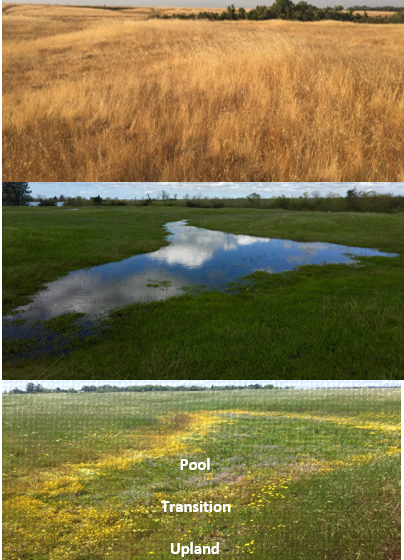In disturbance-adapted ecosystems, the removal of disturbance can lead to losses of diversity and sometimes irreversible changes in community composition. In their latest research, Michaels and colleagues identify the thresholds at which changes occur and explore the reversibility of these shifts in a vernal pool ecosystem in Northern California.
If you head out in search of one of California’s famous vernal pools, you’ll have to navigate through a sea of invasive upland grasses. But even from a distance, these vernal pools are visible through the grasslands—islands of spectacular yellow, pink, and purple wildflower blooms.
Vernal pools have a hard soil layer that causes seasonal ponding each year. Some have formed in the same spot for millions of years. Because it is too wet for upland and too dry for wetland species, this cycle creates a refuge for hundreds of specially evolved native plant species. As the pools dry down in stages, different habitat zones emerge, consisting only of the plants that are adapted to live in that specific set of hydrologic and soil conditions. However, the invasive grasses which have a chokehold on the uplands have begun to encroach into vernal pools, threatening these rare and endangered plant communities.
These pools have a long history of grazing—they likely evolved with native ungulates, such as Tule elk, and many are now located on commercial ranches. Several decades ago, it was assumed that cattle negatively impacted vernal pools, and grazing was removed from most conservation areas. However, over time, managers and researchers observed that total grazing exclusion led to further losses of plant diversity as invasive grasses began to encroach in the pools. Currently, cattle grazing is being reintroduced to many conservation areas in hopes of restoring this diversity.

As restoration ecologists, we often ask, what are the effects of adding or removing disturbance in an ecosystem? Are these effects reversible, or has the system changed past a ‘threshold’ beyond which restoration to the original state is unfeasible? If a threshold has been crossed, then restoring disturbance could send the system on a different trajectory or even cause further decline. In the case of our vernal pools, we asked, does reintroducing cattle return these pools to their pre-exclusion plant community, or does several decades of grazing exclusion result in one of these thresholds, so that reintroduction of grazing fails to restore plant diversity?
Our study took place in a vernal pool reserve in Sacramento County, CA. Livestock were excluded from a portion of this reserve in the 1970’s. In January 2016, managers exposed this area to grazing again for the first time in 40 years.
We installed temporary electric fencing to prevent grazing on some pools in this area, creating three different grazing management treatments: long-term grazed (100+ years), grazing excluded (40+ years of no grazing), and short-term grazed (2 years of reintroduced grazing after 40 years of exclusion). We selected 36 total pools to compare, matching pools based on soil type and pool size.

In each of the pools, we measured the relative cover of native plants as well as overall plant diversity. We focused our sampling efforts in the transition zone ecotones within the pools where the pool bottom meets the non-inundated uplands surrounding the pool.
The transition zones are small in area compared to the area of the uplands and pool bottoms, but are areas of conservation concern because of their high diversity and sensitivity to grazing. We also measured pool characteristics, both grazing and non-grazing related, that may influence plants, including residual dry matter, shape, basin depth, standing water depth, and hoofprint cover.

Our results were clear—vernal pools in which grazing had been reintroduced reached similar levels of native cover to the continuously grazed pools after just two years. Overall plant diversity also increased with reintroduction, but it remained slightly lower than the pools with continuous grazing. If diversity in the pools with grazing reintroduction continues to increase at the rate we observed, then it will match the continuously grazed pools in a couple of years.

We found that plants responded most strongly to hoofprint cover. Hoof print microdepressions potentially provided pockets of low-elevation, wetter refugia for native species which exclude the dominant grasses. This may have interesting implications for management. Since grazing may be most important when the soil is saturated, allowing for these hoofprints to be formed, these hoofprints can persist for several years after grazing. However, since we know that the outcomes of grazing can be highly context-dependent, we suggest that this result be verified in a range of soil and other environmental conditions, and at different times of the season.
At our site, we found evidence that the negative impacts of prolonged grazing exclusion exhibit reversible, rather than ‘threshold’ dynamics. Land managers interested in restoring diversity should plan to monitor beyond the first two years of grazing reintroduction, since diversity may take longer to respond fully.
This evidence for reversible dynamics is a positive sign for the compatibility of ranching and vernal pool conservation. The collaboration between ranchers and conservationists is especially important as vernal pool ecosystems continue to be threatened by urban and agricultural land conversion.
Read the full Open Access paper Vernal pool wetlands respond to livestock grazing, exclusion and reintroduction in Journal of Applied Ecology.
